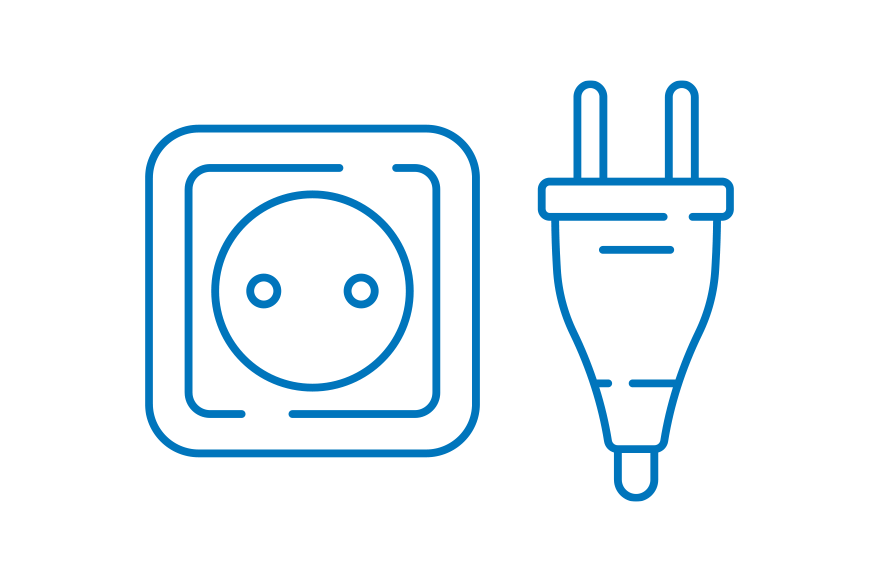Why Do Voltages Differ in Different Countries?
Electricity voltages vary between countries due to historical reasons. When electricity was first introduced, there was no standard voltage or frequency. Countries, therefore, adopted the voltage level of the original equipment installed. For instance, the US uses 120V because this was the voltage level of Thomas Edison’s original DC supply system. Over time, this became the standard voltage.
Why Are Plugs and Sockets Different in Some Countries?
Similarly, plug and socket designs vary because there was no international standard when they were first developed. Different countries created their methods based on their unique safety concerns, electrical grid capacities, and other factors. These designs then became the national standard.
Electricity and Sockets Used in Bulgaria
Bulgaria uses Type F sockets and operates on a 230V supply voltage and 50Hz. Type F is a round plug with two round pins and two earth clips on the side. It’s also known as “Schuko” and is used widely across Europe.

Should you have further questions, we encourage you to visit the World Plugs resource provided by the International Electrotechnical Commission.
Quick Decision Schema (what you need in Bulgaria)
- Check the label on the device/charger.
– If it says “100–240V, 50/60Hz” → it’s dual-voltage. Will work in Bulgaria.
– If it says “120V, 60Hz” only → it’s single-voltage (US). Will not work in Bulgaria. - Check the plug you have. Bulgaria = Type F (Schuko), 230V, 50Hz.
– Two-pin Type C and CEE 7/7 (E/F hybrid) plugs fit.
– US A/B, UK G, CH J, AU/NZ I → need a plug adapter.
– Use a grounded adapter for 3-prong devices. - If single-voltage (120V only) and you must bring it → you need a step-down transformer (230→120V) sized to at least 1.5–2× the device’s wattage. Avoid “lightweight travel converters” for electronics.
| Device / Examples | Label on device (typical) | Will it work? | What you need | Notes / Risks |
|---|---|---|---|---|
| Phones, tablets, laptops, cameras | 100 - 240V, 50/60Hz | Yes | Plug adapter (grounded if 3-prong) or EU power cord (C7/C5) | Most chargers are universal. Bring a Schuko plug lead for neatness. |
| Game consoles, streaming boxes, routers | Often 100 - 240V, 50/60Hz | Plug adapter (check brick label first) | Older/US-only bricks may be 120V - verify before plugging in. | |
| E-readers, smartwatches, power banks | 100 - 240V, 50/60Hz | Yes | Plug adapter | Low wattage; easy. |
| CPAP machines | Usually 100 - 240V, 50/60Hz | Usually | Plug adapter; consider surge protection | Check label; pack spare mask & a small backup battery if power reliability matters. |
| Cordless tool chargers (DIY) | Mixed: many 100 - 240V | May require transformer | Plug adapter if dual-voltage; else transformer | High inrush current - buy a transformer with comfortable headroom. |
| UK appliances (Type G), EU 230V | 220 - 240V, 50Hz | Yes | G to F plug adapter (fused) | Voltage/frequency match; just adapt the plug. |
| Swiss appliances (Type J), EU 230V | 220 - 240V, 50Hz | Yes | J to F plug adapter | Voltage/frequency match. |
| Small US electronics (radios, chargers) 120V only | 120V, 60Hz | With transformer | Step-down transformer (>=1.5 - 2 x W) | Fine for low-watt devices; frequency usually OK, but clocks can drift. |
| Kitchen mixers, fans (AC motor), 120V only | 120V, 60Hz | With transformer | Step-down transformer (oversized) | On 50Hz, many 60Hz motors run slower/hotter ? wear & noise; long-term use not advised. |
| Hair dryers/straighteners, kettles, toasters (US) | 120V, 60Hz, high W | Impractical | A huge transformer (1.5 - 2 kW) - don't | Too power-hungry; buy a dual-voltage travel unit or local 230V version. |
| Turntables, clock radios (synchronous motors) | 120V, 60Hz | Very poor | Transformer + speed/frequency solution | 50Hz causes 20% speed error; even with transformer, speed will be wrong. |
| US power strips with surge protector (120V rated) | 120V only | No | Can fail/burn at 230V. Use an EU-rated strip instead. |
Don’t Bring It list (won’t work or not worth it)
- 120V high-watt heaters (hair dryer, curling/straightening iron, kettle, toaster, space heater).
- Synchronous-motor gear tied to 60Hz (many turntables, clock radios).
- 120V-only power strips and some surge protectors (not 230V-rated).
Minimal Bulgaria Kit
- Grounded Type F (Schuko) plug adapter (or a compact universal with Schuko output).
- Spare EU power leads for laptops (figure-8 C7 or “cloverleaf” C5 with Schuko plug).
- If absolutely needed: a true step-down transformer 230→120V sized to 2× your device’s watts (electronics only; not for hair tools).
- Optional: small EU-rated surge protector for sensitive electronics.
Golden rule: If the label says 100–240V, 50/60Hz, you’re good to go—adapt the plug. If it says 120V, 60Hz only, consider a transformer (low-wattage) or buy a local/dual-voltage (high-wattage) option.


